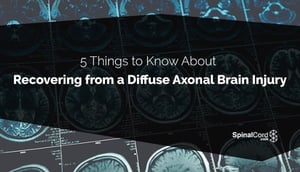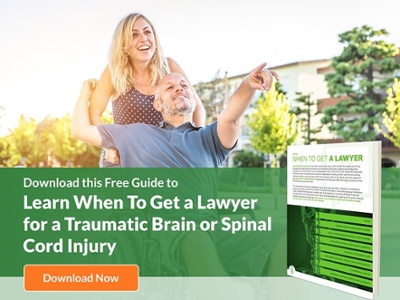5 Things to Know About Recovering from a Diffuse Axonal Brain Injury
There are many different kinds of brain injuries that can occur, but some of the worst injuries are the ones that affect multiple areas of the brain. For example, shaken-brain injuries arising from car accidents and other violent impacts have a risk of becoming diffuse axonal brain injuries.

Here are five questions to ask about diffuse axonal brain injuries:
1: What Is a Diffuse Axonal Brain Injury?
A diffuse axonal brain injury is a traumatic brain injury (TBI) that produces brain lesions in the white matter of multiple areas of the brain—that’s why they’re called “diffuse.” Such injuries should always be considered severe, as they affect several different regions of the brain and may be life-threatening.
2: What Are the Symptoms of a Diffuse Axonal Brain Injury?
One of the challenges of dealing with an axonal brain injury is that these injuries can have different effects that mirror the symptoms of other brain injury types. Specific symptoms may vary greatly depending on which areas of the brain are affected, injury severity, the injured person's overall health, the treatment they receive, and many other factors that even specialist doctors don’t fully understand.
This can make it hard to diagnose the brain injury as being a diffuse axonal brain injury or to pinpoint specific symptoms. So, a doctor will not typically diagnose a condition as a diffuse axonal brain injury without first getting detailed neural imaging of the injury to identify brain lesions.
However, even neural imaging doesn’t always reveal brain lesions on the first try, so it may take repeated imaging scans to fully identify these particular kinds of brain injuries.
3: What Causes Diffuse Axonal Brain Injuries?
A diffuse axonal brain injury is usually caused by violent blows to the head or other events that shake the brain, such as:
- Car accidents
- Sporting injuries (football tackles, head-first impacts with sporting equipment, etc.)
- Falls (particularly those that cause rapid whipping motions of the head)
- Shaken baby syndrome—children are particularly susceptible because their brains are still developing.
Basically, any head injury or whiplash event can cause a brain injury that affects more than one region of the brain.
4: Can I Recover Fully?
For some, recovering from a diffuse axonal brain injury is possible—but there are no guarantees with such injuries. The severity of the brain lesions, which areas of the brain they are in, your treatment, and many other factors can affect whether or not you make a full recovery.
Many who suffer extensive brain injuries such as this may have to struggle with ongoing brain and nervous system issues for the rest of their lives.
5: What Should I Do if I Suspect That I or a Loved One Has a Brain Injury?
If you haven’t already, seek immediate medical attention following a brain injury. If a loved one is injured, DON’T move them unless you absolutely have to—sudden motion may aggravate a brain or spinal injury and make things worse. Advise paramedics about any potential brain or spinal injuries when they arrive.
After the injury has been stabilized, the process of rehabilitation can begin. If you suffer a brain injury, be sure to follow the treating doctor’s instructions as best as you can, and don’t be afraid to ask for help.
If a loved one suffers a brain injury, be there to support them as best as you can. There will be a long period where they’ll have to adjust to their new reality, and you may have to make some adjustments yourself. You may need to help them manage their basic living needs, such as helping with their finances so they don’t fall behind on bills.
Brain injuries of any kind are a serious issue. And, according to statistics from the CDC, “an estimated 1.5 million Americans sustain a TBI” each year. While many do eventually recover from these injuries, an approximate 50,000 people die and 230,000 more are hospitalized for traumatic injuries to the brain every year—and 80,000 or more suffer long-term disabilities because of their injuries.

Being aware of the risks and effects of severe brain and spinal cord injuries is the first step—one you’ve already taken by choosing to read and learn more about diffuse axonal brain injuries in this blog. To learn more about brain and spinal cord injuries—their effects and their treatments—please check out some of our other resources.
Stay Updated on Advancements On Traumatic Brain &
Spinal Cord Injuries
About the Author




